MAPKAPK2
-
Official Full Name
mitogen-activated protein kinase-activated protein kinase 2 -
Overview
This gene encodes a member of the Ser/Thr protein kinase family. This kinase is regulated through direct phosphorylation by p38 MAP kinase. In conjunction with p38 MAP kinase, this kinase is known to be involved in many cellular processes including stress and inflammatory responses, nuclear export, gene expression regulation and cell proliferation. Heat shock protein HSP27 was shown to be one of the substrates of this kinase in vivo. Two transcript variants encoding two different isoforms have been found for this gene. -
Synonyms
MAPKAPK2;mitogen-activated protein kinase-activated protein kinase 2;MAP kinase-activated protein kinase 2;MAPKAP kinase 2;MAPK-activated protein kinase 2;MK2;MK-2;MAPKAP-K2
Recombinant Proteins
- Human
- Mouse
- E.coli
- Sf9 Cells
- HEK293
- Mammalian Cells
- HeLa
- Sf21 Cells
- GST
- His
- Non
- T7
- Avi
- Fc
- DDK
- Myc
Background
What is MAPKAPK2 protein?
MAPKAPK2 (MAPK activated protein kinase 2) gene is a protein coding gene which situated on the long arm of chromosome 1 at locus 1q32. This gene encodes a member of the Ser/Thr protein kinase family which is a regulator of the MAPK signaling pathway and can be activated by multiple activated MAPK (Mitogen-Activated Protein Kinase) phosphorylation. Once activated, MAPKAPK2 can participate in multiple biological processes within the nucleus and in the cytoplasm by directly phosphorylating multiple substrate proteins. The MAPKAPK2 protein is consisted of 400 amino acids and its molecular mass is approximately 45.6 kDa.
What is the function of MAPKAPK2 protein?
MAPKAPK2 plays a role in a variety of cellular processes, particularly in response to environmental stress, apoptosis, and muscle cell differentiation. It regulates cytoskeletal recombination, cell survival, and cellular adaptation to stress responses by phosphorylation of downstream targets, such as the heat shock proteins HSP27 and HSPB1. MAPKAPK2 is also involved in the inflammatory response, activating immune cells and promoting the production of inflammatory factors.
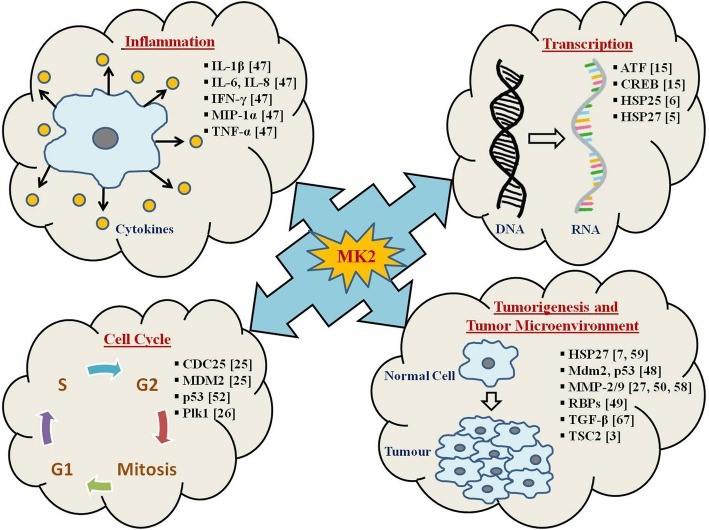
Fig1. The MK2 target genes represented here are play a vital role in cellular processes like cell cycle, inflammation, transcription, tumorigenesis and tumor microenvironment. (Sourabh Soni, 2019)
MAPKAPK2 Related Signaling Pathway
One of the most important signaling pathways of MAPKAPK2 is the MAPK signaling pathway. Activated MAPKAPK2 regulates biological processes such as cell proliferation, survival and differentiation through phosphorylation and activation of a variety of substrate proteins. In the JNK signaling pathway, JNK, another member of the MAPK family, can also activate MAPKAPK2 under certain conditions, thereby affecting cell apoptosis, proliferation and differentiation. In addition, it is also involved in inflammatory response, metabolic regulation and other processes.
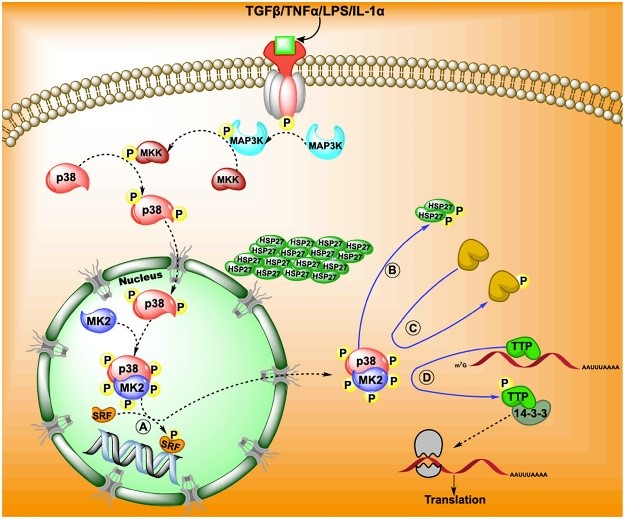
Fig2. A brief overview of the canonical pathway for p38 MAPK-MK2 pathway and the downstream effects following MK2 phosphorylation. (Deri Morgan, 2022)
MAPKAPK2 Related Diseases
Abnormal activation of MAPKAPK2 has been associated with the development and progression of multiple tumors, including breast cancer, colorectal cancer, and non-small cell lung cancer. In addition, abnormal activation of MAPKAPK2 is associated with the occurrence and development of diseases such as chronic inflammation, autoimmune diseases and neurodegenerative diseases. MAPKAPK2 plays a role in muscle cell differentiation and stress response, and its abnormal activity may be related to the occurrence and development of muscle diseases (such as muscular dystrophy, muscular atrophy, etc.).
Bioapplications of MAPKAPK2
Through the establishment of cell and animal models of MAPKAPK2 gene knockout or overexpression, MAPKAPK2 is mainly used in laboratory studies to explore the mechanism of cell signaling, the construction of disease models, and the validation of potential drug targets. Although MAPKAPK2 itself is not a drug or directly used for clinical treatment, it could be important for future drug development as a potential drug target.
Case Study
Case study 1: Jose B Saenz, 2010
Mounting evidence suggests that Shiga toxin (STx) activates stress response pathways in susceptible cells and has implicated the p38 mitogen-activated protein kinase (MAPK) pathway. More importantly, some of the pathology associated with haemolytic uremic syndrome (HUS) is believed to be a result of a STx-induced inflammatory response. However, the mechanism is not clear.
From a siRNA screen of the human kinome adapted to a high-throughput format, the researchers found that knock-down of MK2 protected against Shiga toxicity. Further characterization of the in vitro role of MK2 revealed that STx activates the p38-MK2 stress response pathway in both p38- and MK2-dependent manners in two distinct cell lines. MK2 activation was specific to damage to the ribosome by an enzymatically active toxin and did not result from translational inhibition per se. These findings suggest that MK2 inhibition might play a valuable role in decreasing the immuopathological component of STx-mediated disease.
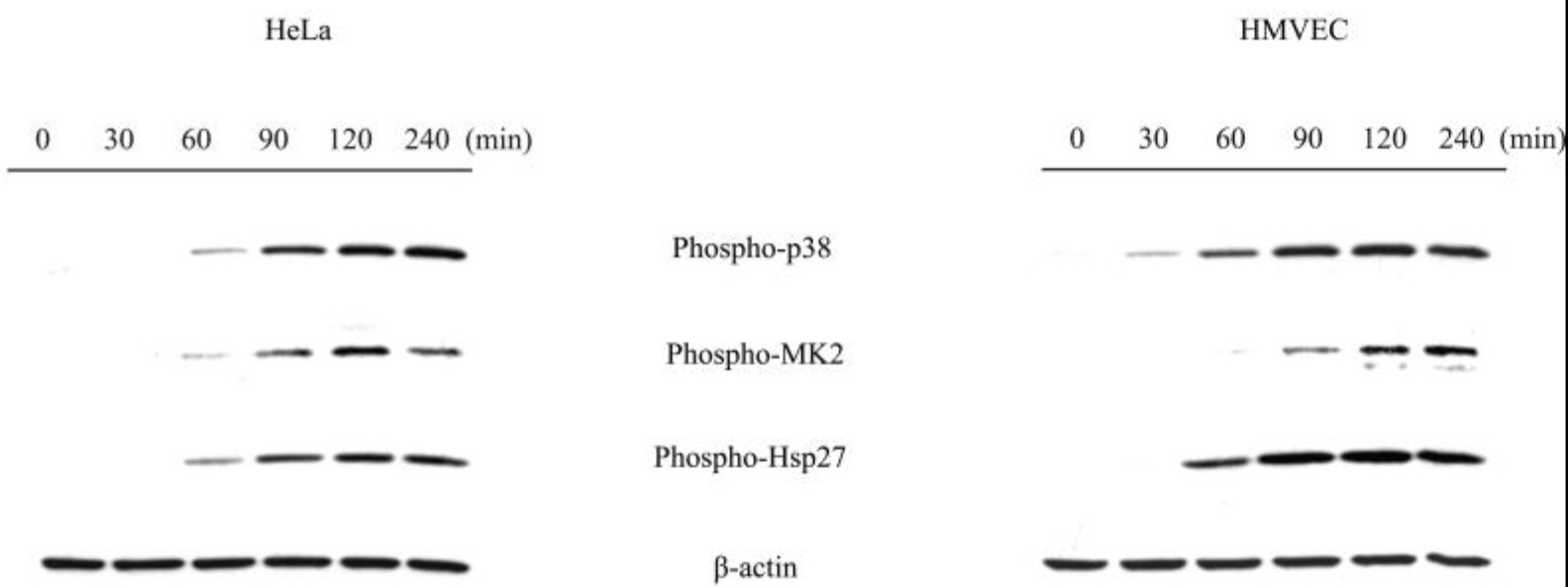
Fig1. STx1 specifically induces activation of the p38-MK2 pathway in both HeLa and HMVEC in time- and dose-dependent manners.
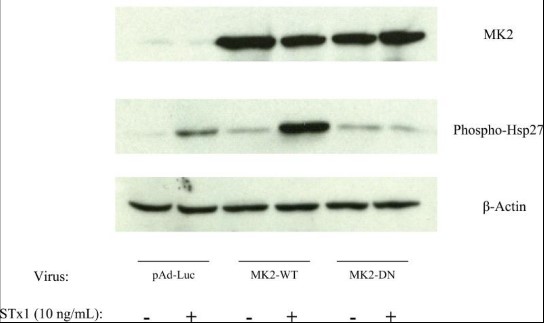
Case study 2: Nicolás Herranz, 2015
Senescent cells secrete a combination of factors collectively known as the senescence-associated secretory phenotype (SASP). The SASP reinforces senescence and activates an immune surveillance response, but it can also show pro-tumorigenic properties and contribute to age-related pathologies. In a drug screen to find new SASP regulators, we uncovered the mTOR inhibitor rapamycin as a potent SASP suppressor. Here we report a mechanism by which mTOR controls the SASP by differentially regulating the translation of the MK2 (also known as MAPKAPK2) kinase through 4EBP1.
In turn, MAPKAPK2 phosphorylates the RNA-binding protein ZFP36L1 during senescence, inhibiting its ability to degrade the transcripts of numerous SASP components. Consequently, mTOR inhibition or constitutive activation of ZFP36L1 impairs the non-cell-autonomous effects of senescent cells in both tumour-suppressive and tumour-promoting contexts. Altogether, our results place regulation of the SASP as a key mechanism by which mTOR could influence cancer, age-related diseases and immune responses.
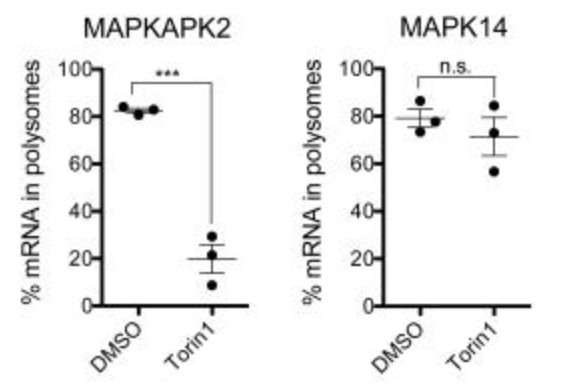
Fig3. The association of MAPKAPK2 mRNA with polysomes significantly decreases upon acute mTOR inhibition.
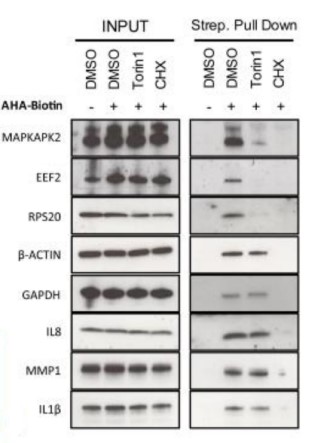
Quality Guarantee
High Purity
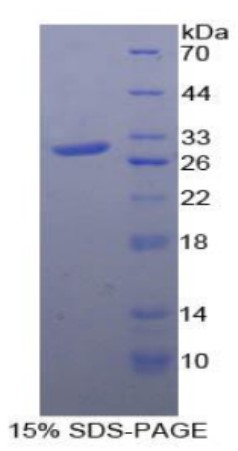
Fig1. SDS-PAGE (MAPKAPK2-6987H) (PROTOCOL for western blot)
.
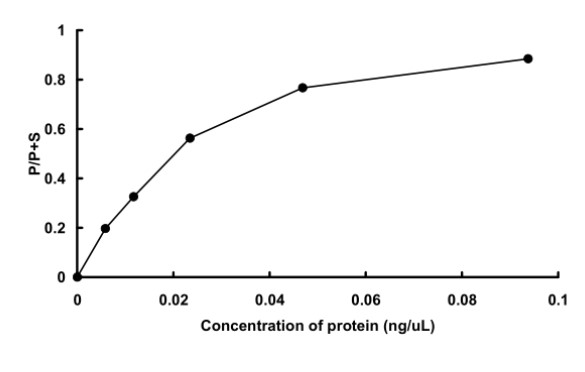
Fig2. Activity Data. (MAPKAPK2-5467HF)
Involved Pathway
MAPKAPK2 involved in several pathways and played different roles in them. We selected most pathways MAPKAPK2 participated on our site, such as MAPK signaling pathway,VEGF signaling pathway,Neurotrophin signaling pathway, which may be useful for your reference. Also, other proteins which involved in the same pathway with MAPKAPK2 were listed below. Creative BioMart supplied nearly all the proteins listed, you can search them on our site.
| Pathway Name | Pathway Related Protein |
|---|---|
| VEGF signaling pathway | NOS3,HRASB,AKT3A,PIK3CA,AKT2,PPP3CA,SHC2,PPP3CB,PTK2AB,RAC3A |
| MAPK signaling pathway | FGF10A,FGF11,FGFR2,ARRB1,GNA12,TGFBR1B,CDC42L,CACNG6,FGF6,CACNA1D |
| Viral carcinogenesis | HIST1H4H,TBPL2,NFKB2,LTBR,HDAC2,HDAC7,KRAS,C3,TBP,HDAC4 |
| Neurotrophin signaling pathway | MAP2K2,SH2B3,MAP3K3,RAP1A,RPS6KA6,CDC42,SOS1,BRAF,MAGED1,CAMK2A |
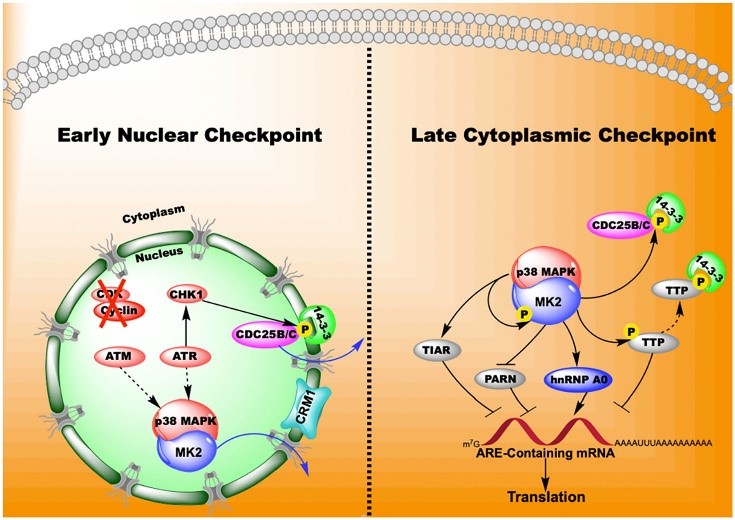
Fig1. MK2 regulates nuclear factor kappa B (NF-κB) transcription by altering the location of p38 MAPK. (Deri Morgan, 2022)
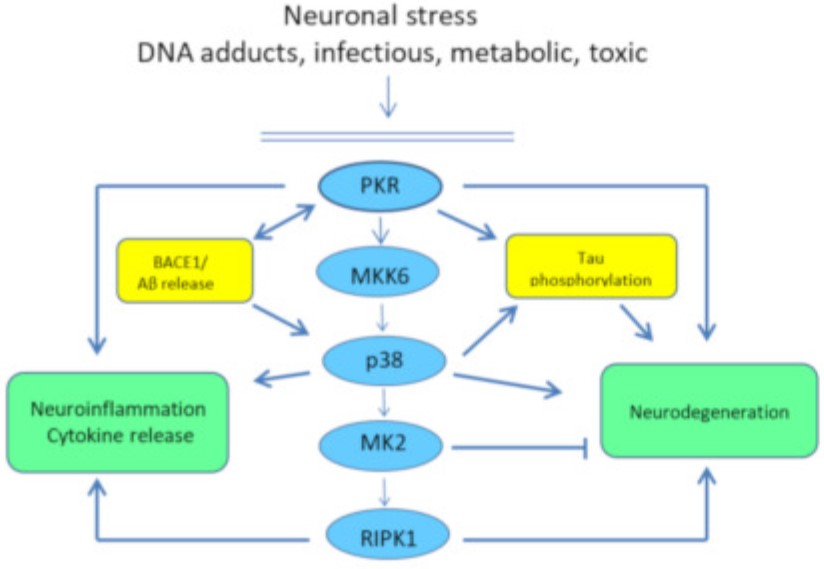
Fig2. Pathological consequences of the activation of the PKR/p38/RIPK1 pathway during neuronal stress and Alzheimer's disease (AD). (Jacques Hugon, 2021)
Protein Function
MAPKAPK2 has several biochemical functions, for example, ATP binding,calcium-dependent protein serine/threonine kinase activity,calmodulin binding. Some of the functions are cooperated with other proteins, some of the functions could acted by MAPKAPK2 itself. We selected most functions MAPKAPK2 had, and list some proteins which have the same functions with MAPKAPK2. You can find most of the proteins on our site.
| Function | Related Protein |
|---|---|
| ATP binding | IPPK,ATP9A,SGK1,PRPS1L1,KIF5B,DGKB,ERBB3B,ACSM1,HIPK2,GLULA |
| protein serine/threonine kinase activity | KSR2,CDK1,MAPK1,SNRKB,LMTK3,GRK1A,STK10,PHKG1B,PAK7,CAMK2G1 |
| protein kinase activity | ROCK2A,KITA,GRK7B,PLK5,IKBKAP,PRKACBA,NPR1A,PDPK1B,MAP3K14,Fert2 |
| calcium-dependent protein serine/threonine kinase activity | MKNK1,MAPKAPK5,MKNK2,MAPKAPK2B,CAMK1GB,MKNK2B,CAMK4,MKNK2A,DCX,CAMK1GA |
| signal transducer activity | OPN1MW4,ADRA2DB,TAAR7D,PLCB3,GNAI3,AVP,STMN1,GPR89,GNAS,FLNA |
| calmodulin binding | SLC9A1,SNTB2,RGS4,MAP6,DCX,MYO7A,ORAI1,GEM,NRGN,GRIN1 |
| protein binding | IL-8,NUCB2,LNX2B,TM4SF4,ANKRD27,GDPD5,FOXO3B,PAK2,RPGRIP1,COBRA1 |
| mitogen-activated protein kinase binding | NBR1,MAPKAPK5,DUSP2,EP300,ARRB2,PLCB4,ABL1,PTPRJ,TPR,ATF7 |
| calmodulin-dependent protein kinase activity | CAMK2G1,CAMK2D,CAMK2B,MAPKAPK5,PTK2B,DCX,MYLK3,CAMK1GB,CAMK2A,PNCK |
Interacting Protein
MAPKAPK2 has direct interactions with proteins and molecules. Those interactions were detected by several methods such as yeast two hybrid, co-IP, pull-down and so on. We selected proteins and molecules interacted with MAPKAPK2 here. Most of them are supplied by our site. Hope this information will be useful for your research of MAPKAPK2.
MAPK14;HSPB1;HSF1;STAT3;saicar;ALOX5;PKM
Resources
Research Area
Related Services
Related Products
References
- Jamesdaniel, S; Ding, DL; et al. Analysis of Cochlear Protein Profiles of Wistar, Sprague-Dawley, and Fischer 344 Rats with Normal Hearing Function. JOURNAL OF PROTEOME RESEARCH 8:3520-3528(2009).
- Felix, RS; Colleoni, GWB; et al. SAGE analysis highlights the importance of p53csv, ddx5, mapkapk2 and ranbp2 to multiple myeloma tumorigenesis. CANCER LETTERS 278:41-48(2009).



